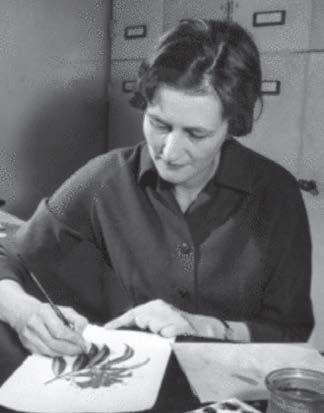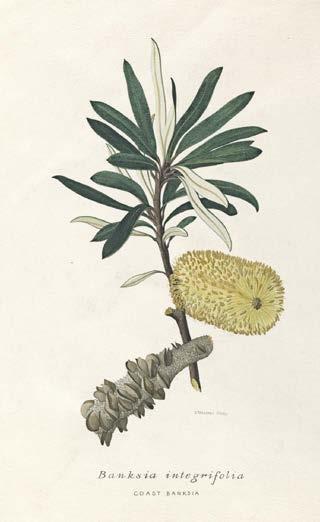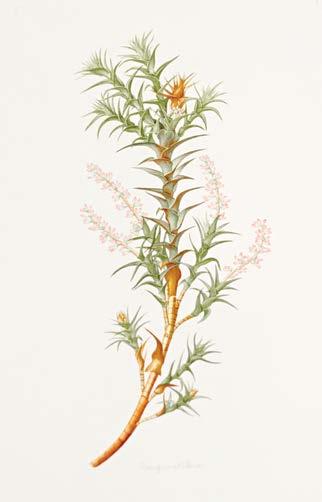
6 minute read
Beauty in Truth The Botanical Art of Margaret Stone
The following is an extract from article that originally appeared in The Botanical Artist - Volume 16, Issue 3Elsie Margaret Stones and the Flora of Louisiana By Elaine B. Smyth
Melbourne, Australia, 1945. A young art student turned nurse contracts pneumonia. Doctors prescribe eighteen months of bed rest in hospital. Friends and family visit the impatient patient and find her “going mad with boredom.” They bring her paper, pencils, watercolors, and wild flowers, from the nearby Grampian Mountains, to draw. Thus begins the career of one of the twentieth century’s most distinguished botanical artists, which resulted in the creation of three major bodies of work on three continents. Elsie Margaret Stones – always called Margaret – was born in Colac, Australia, southwest of Melbourne, on August 28, 1920. Her father, Frederick Stones, had been a farmer in the district, and her mother, Agnes, came from nearby Terang. The 1920s and 30s were difficult times in Australia, particularly for farmers, who suffered both economic and social upheaval. The Stones family struggled throughout those decades, moving from place to place as farms failed, sometimes unable to live together.
Advertisement
As a child, Margaret loved to draw and despite the upheaval of those early years, her family encouraged and supported her in her artistic endeavours. After attending Swinburne Girls’ Junior Technical School in Melbourne, she won a three-year scholarship to study Industrial Art at Swinburne Technical College (now Swinburne University of Technology). Already sure of her preferred profession at age fifteen, she entered her occupation in her student records as “artist.” Forced to leave school when her scholarship expired, she earned a living doing commercial art during the day, but continued to study, attending night classes at the National Gallery of Victoria Art School, until World War II intervened.
Although Australia entered World War II in 1939, declaring war against Germany, it wasn’t until December 1941 that the war moved into the Pacific. In 1942, as part of the home-front war effort, Stones began working as a nurse at the Epworth Hospital in Richmond, a suburb of Melbourne. In late 1945, she contracted pulmonary tuberculosis and was hospitalized. The drawings she made of wildflowers while convalescing attracted the attention of her physician, Dr. Clive Fitts. Through his good offices, her work was seen by Daryl Lindsay, Director of the National Gallery of Victoria, and Robert Haines of Georges Gallery, Melbourne, who gave Stones her first solo exhibition, which opened in December 1946. It was a critical success. In a remarkable burst of productivity, she went on to produce three more gallery exhibitions within four years, while at the same time completing a major commission for a private collector, John McDonnell, attending botany lectures at the University of Melbourne, and spending three summers as part of a botanical expedition to the Bogong High Plains of Victoria. Her time on the Bogong Plains was the result of another important personal connection made by Clive Fitts, who introduced her to John Stewart Turner, Professor of Botany and Plant Physiology at the University of Melbourne. Because of Turner, Stones began not only to study botany and its historical development but also the history of botanical illustration, which she has continued to focus on throughout her life. As her knowledge of botany and botanical illustration grew, she grew determined to work and study at the Royal Botanic Gardens, Kew, where distinguished artists had worked with noted botanists since the gardens were founded in 1759. By 1951, she had saved enough to purchase a oneway passage on a ship bound for England. She made the voyage armed with a letter of introduction from Daryl Lindsay to Harold Wright, a Director of Painting
Margaret Stones at the Herbarium, Kew1962

Anigozanthos manglesii, Tribonanthes australis and Conospermum stoechadis (Kangaroo paw and Smoke bush) (c. 1946) & Drawing, and Colnaghi Gallery, a noted dealer in prints and drawings. Within months, Colnaghi had given her an exhibition, and the firm continued to represent her until the 1970s.

Shortly after arriving in London, Stones found lodgings near Kew, where she continued to live until she returned to Australia in 2002. Soon she was engaged as a freelance artist at Kew, and in 1956 her first drawing – an analytical drawing in pen and ink – was published in Curtis’s Botanical Magazine, the journal affiliated with the Royal Botanic Gardens at Kew. Over the next twentyfive years, she created the first of her major bodies of work, consisting of more than 400 drawings made for that magazine. When she first arrived at Kew, Stones spent many hours making pen-and-ink drawings of herbarium specimens that had been dried and then boiled to rehydrate them, and dissected under a microscope. Writing about her work later, she noted that this provided invaluable training for botanical drawing for someone with her more general background and training in art. Over time she determined that for her watercolor portraits of plants, she would work only from live specimens, eschewing the use of photographs. She developed the general habit of working indoors, with the specimen and a microscope at hand, but her indoor work was frequently supplemented with field work that gave her a sense of plants’ natural habits and habitats.
During her decades at Kew, she pursued other projects as well. In 1961, Milo John Reginald Talbot, 7th Baron Talbot de Malahide, wrote to Stones to ask her to draw the plants of Tasmania, where he had come into possession of an estate in 1940. Plants were airshipped from Tasmania to Kew for her to draw. By 1962, she had completed forty drawings for him. With that collection of drawings in hand, Talbot de Malahide approached John Roberts of the Ariel Press, London, with an idea for The Endemic Flora of Tasmania. With botanical commentary by Dr. Winifred Curtis and outstanding color printing done by Ariel, the book proved a stunning success. As the stream of air-freighted specimens continued, Stones created 254 drawings to illustrate the six-volume work, which was completed in 1978. As the Tasmanian project was drawing to a close, a project in Louisiana began – her last major body of work on a third continent. In 1976, Stones was commissioned to create six watercolor drawings of Louisiana native flora

Eucalyptus preissiana 1963 to be a lasting legacy of Louisiana State University’s bicentennial celebration. The LSU community was thrilled with the result, and the project soon blossomed with the support of people throughout the state. Professor Lowell Urbatsch of LSU was recruited as the chief botanical advisor, and dozens of people from all across the state contributed funds and time to make the project a success. An important difference between the Tasmanian project and the Louisiana work was that Stones’ method of working only from live plant material made it imperative that she visit Louisiana regularly. Unlike the tough Tasmanian flora, Louisiana native plants could not survive air shipment. Stones first visited Baton Rouge in February, 1976, beginning an association that produced not only a significant collection of botanical art but also many enduring friendships. Writing Beauty in Truth: The Botanical Art of Margaret Stones (the best single source of information about the artist), Irena Zdanowicz describes Stones’ working methods and the demands made by her exclusive use of live specimens: “She works swiftly and instinctively, partly from temperament, but also from a conviction that it is crucial to portray the plant as a living object whose true delineations must be captured before it begins to wilt and its colours change. Not infrequently, the plant’s behavior demands speed of execution…. [On one occasion] the audible click of buds opening on a branch of magnolia – kept overnight in the humid atmosphere of a bathroom – had her leaping from bed in the early hours of the morning to draw them. The two sketches and the finished drawing of the same specimen of Magnolia macrophylla … document the slight but unmistakable movement of leaves and buds over a short period of time – differences of detail which otherwise could, erroneously, be seen as a case of artistic licence.”

In 1977 Stones was made a Member of the British Empire and in 1988 a Member of the Order of Australia for “service to art as an illustrator of botanical specimens”. Stones died at Epworth, Richmond, Victoria on 26 December 2018 at the age of 98. She never married.
Images sourced from https://www.ngv.vic.gov.au for educational purposes










